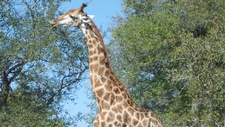Adaptations

TEKS Objective
Explore how adaptations enable organisms to survive in their environment such as comparing birds’ beaks and leaves on plants.
Essential Understanding
The student knows that organisms undergo similar life processes and have structures that help them survive within their environment.
Science Background
Plant Adaptations: Missouri Botanical Garden (website) - Interactive site that describes and explains plant adaptations to different biomes.
Plant Adaptations
Missouri Botanical Garden, www.mbgnet.net
Adaptation: University of California Museum of Paleontology (website) - An adaptation is a feature that is common in a population because it provides some improved function. Adaptations are evident in both plants and animals. Explore this website and its links for information and lesson plans focusing on evolution, adaptation and more.
Adaptations
University of California Museum of Paleontology, www.ucmp.berkeley.edu
Signature Lesson
Animal Adaptations Create-a-creature: San Diego Zoo (website) - Using imagination and simple materials, students design habitats, “create” animals that are specifically adapted to these habitats, and write a natural history for their animals, including information about its adaptations, environment, behaviors, etc.
Animal Adaptations Create-a-creature
San Diego Zoo, www.sandiegozoo.org
Bird Beaks: Science NetLinks (website) - Students explore how different kinds of bird beaks enable birds to use food sources and survive in a variety of environments.
- Supporting Lessons
- Extensions
- Assessment Ideas
- Literature Connections
- Related
TEKS - Additional Resources
Supporting Lessons
Animal Adaptations: National Park Service (PDF) - Field trip guide with lessons that can be used in the classroom to learn about a variety of animal adaptations to desert environments.
Animal Adaptations
National Park Service, www.nps.gov
Plant Adaptations: National Park Service (PDF) - Field trip guide with lessons that can be used in the classroom to learn about a variety of plant adaptations to desert environments.
Plant Adaptations
National Park Service, www.nps.gov
Adaptations, Fit for Survival: Journey North (website) - Students explore the meaning of physical and behavioral adaptation, and investigate animal migrations as an adaptation for survival. The site features maps that show tracking reports of migrating butterflies and humming birds. Additional links focus on other animals, such as cranes and gray whales.
Adaptations, Fit for Survival
Annenberg Learner, Journey North, www.learner.org
Elaboration Lessons and Extensions
Patterns and Adaptations in Plants and Animals: University of Texas Dana Center (PDF) - Students research patterns and adaptations among native plants and animals in different regions of Texas and identify adaptations of various plants and animals that increase their survival rates.
Patterns and Adaptations in Plants and Animals
University of Texas Dana Center, www.utdanacenter.org
Fire Adaptations: National Park Service (website) - Students investigate plant and animal adaptations to survive wild fires and “design” a plant that is adapted to survive fire.
Assessment Ideas
Functions of Animal Adaptation: VTaide.com (PDF) - Use questions and photographs from these worksheets on animal adaptations to enhance an activity or as a stand-alone assessment.
Literature Connections
Would You Survive? Animal and Plant Adaptation. Townsend, John (ISBN-13: 978-1410919694)
The Most Extreme Animals. Gerstein, Sherry (ISBN-13: 978-0787986629)
The Science Behind Animal and Plant Survival. Brasch, Nicolas (ISBN-13: 978-1599205595)
How Do Animals Adapt? Kalman, Bobbie (ISBN-13: 978-0865059573)
What Do You Know About Animal Adaptations? Slade, Susan (ISBN-13: 978-1404241992)
How Plants Survive. Kudlinski, Kathleen (ISBN-13: 978-0791074220)
Exploring the Native Plant World: Adaptations. Johnson, Lady Bird (ISBN-13: 978-1571688514)
Plant Survival: Adapting to a Hostile World. Capon, Brian (ISBN-13: 978-0881922875)
Plant Adaptations. Lundgren, Julie (ISBN-13: 978-1617419379)
Additional Resources
Animal Adaptation Teacher Guide: The Zoo Society (PDF) - This comprehensive unit, designed to support a self-guided tour of the Milwaukee County Zoo, contains a wealth of information and activities on animal adaptations that can be used in any classroom.
Animal Adaptation Teacher Guide
The Zoo Society, www.zoosociety.org
Animal Adaptations: Utah Education Network (website) - Discussion questions and links to an extensive list of websites with information on many different animals’ adaptations to their habitats.
Animal Adaptations
Utah Education Network, www.uen.org
All About Fish: Sea World (website) - Compare the mouths and caudal (tail) fins of different fish to promote discussion of adaptations. A second page includes information about fish body shape and color.
All About Fish
Sea World, www.seaworld.org
Ecokids Animal Adaptation: Ecokids (website) - Have students play the EcoKids Animal Adaptation game to expand their knowledge.
TEKS Navigation
Grade 4
Need Assistance?
If you need help or have a question please use the links below to help resolve your problem.

Comments